Nicole schreibt...
Rhodos 2021 |
 |
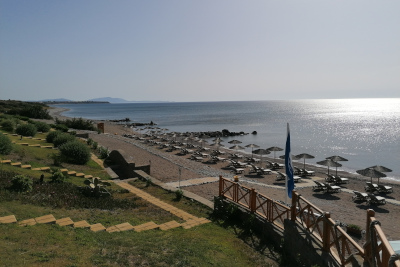 Way way back many years ago the Greek island of Rhodos (or Rhodes for you Anglos) was the first big holiday destination my mother and my aunt took me to as a mere five year old between kindergarten and elementary school. I don't remember much of the trip of course, but I am still grateful that they dragged me onto a plane and to a far-away island, opening up my world this early and instilling me with a sense that I could go anywhere if I wanted to.
Way way back many years ago the Greek island of Rhodos (or Rhodes for you Anglos) was the first big holiday destination my mother and my aunt took me to as a mere five year old between kindergarten and elementary school. I don't remember much of the trip of course, but I am still grateful that they dragged me onto a plane and to a far-away island, opening up my world this early and instilling me with a sense that I could go anywhere if I wanted to.And for some years there had been talk about re-visiting Rhodos after all this time, but usually something else interfered. This winter, at the height of Corona frustration, it finally seemed a good idea to book a trip to Rhodos for late spring to have something to look forward to - quite blithely assuming that the pandemic would be over by then. Of course that didn't happen and we were lucky that Greece only just opened up for international tourism two weeks before the planned departure date. And as it turned out, the hotel we had booked - the Atrium Palladium in touristy Ialysos just south of Rhodos City - would not open until mid-June, so they booked us into the sister hotel Atrium Prestige instead.
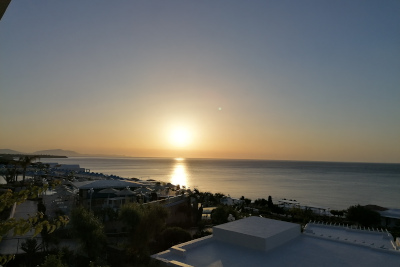 To sweeten the deal, they threw an upgrade to half-board and a junior suite in, which went a long way, but didn't change the fact that the hotel - a sprawling resort - was at the arse-end of the island near the south-eastern tip in the middle of nowhere. That said, it WAS very lovely with a vast pool, its own beach and a buffet to die for, not to mention the spectacular sea view. Personally I also enjoyed the fact that the bathroom came with our own jacuzzi including a "starry sky" and a balcony from which to watch the sunrise as well as a very impressive full moon making the sea glitter in the night.
To sweeten the deal, they threw an upgrade to half-board and a junior suite in, which went a long way, but didn't change the fact that the hotel - a sprawling resort - was at the arse-end of the island near the south-eastern tip in the middle of nowhere. That said, it WAS very lovely with a vast pool, its own beach and a buffet to die for, not to mention the spectacular sea view. Personally I also enjoyed the fact that the bathroom came with our own jacuzzi including a "starry sky" and a balcony from which to watch the sunrise as well as a very impressive full moon making the sea glitter in the night.Flights were rather messy as well, with a flight out of Cologne that was meant to depart at 6am, but was mercifully shuffled forward to 8am when Cologne introduced a Corona curfew from 9pm to 5am that would have made it impossible for people to get to the airport in time. The flight back would be to Duesseldorf though, so we couldn't park at the airport, leaving an early-morning taxi the only possibility to get to the airport. This, combined with the completely useless local representative of the travel operator in Rhodos, convinced me once more that travel operators are ultimately absolutely pointless. Just as on the Maldives, I was left to figure out on my own again how and when to get Corona tests for the journey back, which luckily the hotel offered), so the one thing they could have scored Brownie points with they were a complete failure in again. So thanks, but no thanks, I'll go back to indie travelling from here on.
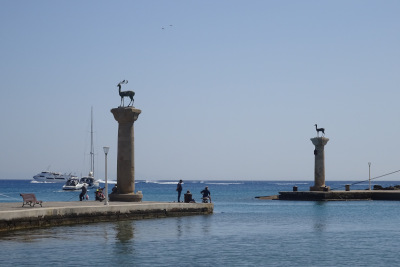 Since the resort was far away from everywhere, we spent the first full day just chilling on the beach and doing nothing much at all, before getting a rental car for two days. The first excursion took us to Rhodos City at the very northern tip of the island, where we could park nearby Mandraki Harbour, where the island's iconic stag and deer have been greeting arrivals by sea for centuries. The legend, that this was the place of the fabled Colossus of Rhodos (one of the Seven Wonders of the Ancient World), has long since been debunked. Fun fact: The Colossus came into being after a siege by Macedonian warlord Demetrius went nowhere in 304 BC. The Macedonians left their stuff behind, which the wily Rhodians smelted or sold and used it to create a 33 metre tall bronze statue of Helios, the Sun God, patron god of the island (about the same height as the Statue of Liberty). Sadly, Helios towered over Rhodos for only 54 years, before an earthquake brought him crashing down. The oracle of Delphi told the Rhodians that they had pissed off Helios and should rather not re-erect the statue, so it remained at the bottom of the harbour for 800 years as a bizarre tourist attraction of sorts which even the Romans wrote about. After the Arabs conquered Rhodos in 653 they hauled the remains from the sea, melted it and sold it to a Jewish merchant who supposedly needed 900 camels to carry all the bronze off. What the statue looked like, no one really knows.
Since the resort was far away from everywhere, we spent the first full day just chilling on the beach and doing nothing much at all, before getting a rental car for two days. The first excursion took us to Rhodos City at the very northern tip of the island, where we could park nearby Mandraki Harbour, where the island's iconic stag and deer have been greeting arrivals by sea for centuries. The legend, that this was the place of the fabled Colossus of Rhodos (one of the Seven Wonders of the Ancient World), has long since been debunked. Fun fact: The Colossus came into being after a siege by Macedonian warlord Demetrius went nowhere in 304 BC. The Macedonians left their stuff behind, which the wily Rhodians smelted or sold and used it to create a 33 metre tall bronze statue of Helios, the Sun God, patron god of the island (about the same height as the Statue of Liberty). Sadly, Helios towered over Rhodos for only 54 years, before an earthquake brought him crashing down. The oracle of Delphi told the Rhodians that they had pissed off Helios and should rather not re-erect the statue, so it remained at the bottom of the harbour for 800 years as a bizarre tourist attraction of sorts which even the Romans wrote about. After the Arabs conquered Rhodos in 653 they hauled the remains from the sea, melted it and sold it to a Jewish merchant who supposedly needed 900 camels to carry all the bronze off. What the statue looked like, no one really knows.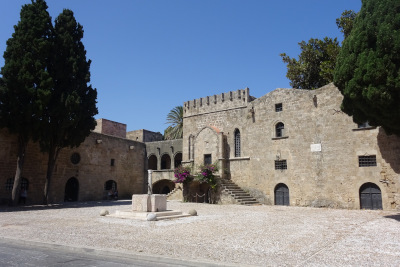 Rhodos City's other claim to fame is the fact that the Old Town, fully enclosed by a medieval town wall, is a UNESCO World Heritage Site. After the Knights of St. John had been evicted from the Holy Land after the Crusades, they first fled to Cyprus and then set up shop in Rhodos City. The Ippoton, the "Avenue of the Knights", is famous for being the only fully preserved medieval street of the Mediterranean, although it's been heavily refurbished over time. It was here the knights' "langues" (the tongues (countries) from which the knights hailed) had built their auberges such as the Auberge de France, which still houses the French consulate today, leading up to the Grand Master's Palace. This had been crumbling heavily when the Italians occupied Rhodos in early 20th century and some bright spark decided to refurbish the palace in case King Vittorio Emmanuele or later their great leader Mussolini popped over for a visit. Neither did, but Rhodos is now stuck with this not very authentic building. The most bizarre bit are the many gorgeous antique mosaics the Italians had filched from the neighbouring island of Kos and inserted into the floors for no good reason whatsoever.
Rhodos City's other claim to fame is the fact that the Old Town, fully enclosed by a medieval town wall, is a UNESCO World Heritage Site. After the Knights of St. John had been evicted from the Holy Land after the Crusades, they first fled to Cyprus and then set up shop in Rhodos City. The Ippoton, the "Avenue of the Knights", is famous for being the only fully preserved medieval street of the Mediterranean, although it's been heavily refurbished over time. It was here the knights' "langues" (the tongues (countries) from which the knights hailed) had built their auberges such as the Auberge de France, which still houses the French consulate today, leading up to the Grand Master's Palace. This had been crumbling heavily when the Italians occupied Rhodos in early 20th century and some bright spark decided to refurbish the palace in case King Vittorio Emmanuele or later their great leader Mussolini popped over for a visit. Neither did, but Rhodos is now stuck with this not very authentic building. The most bizarre bit are the many gorgeous antique mosaics the Italians had filched from the neighbouring island of Kos and inserted into the floors for no good reason whatsoever.
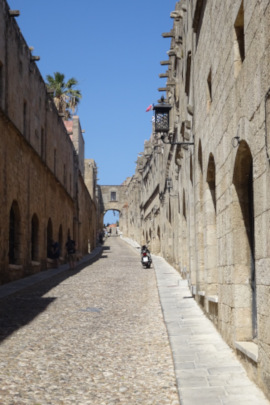
|
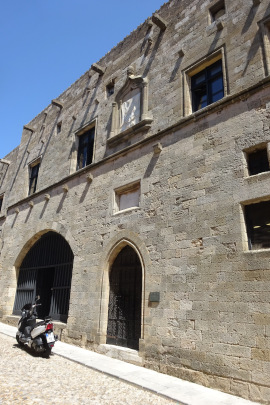
|
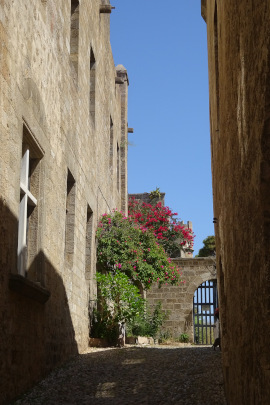 |
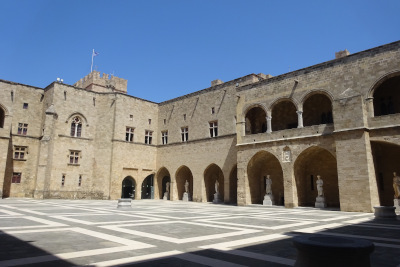
|
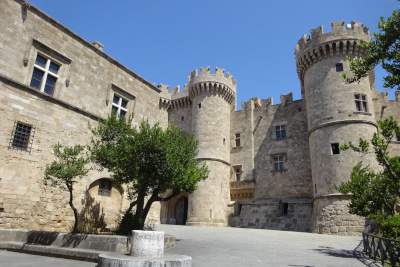 |
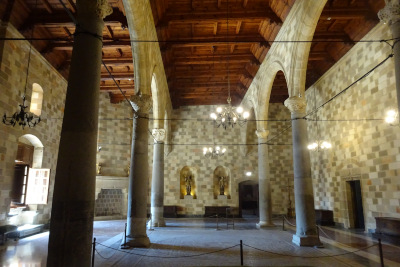
|
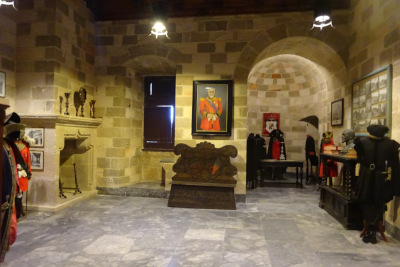 |
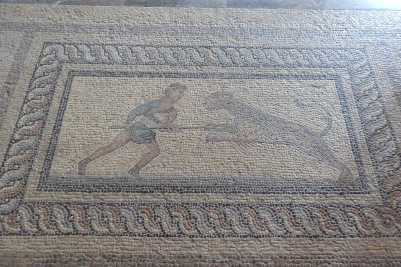
|
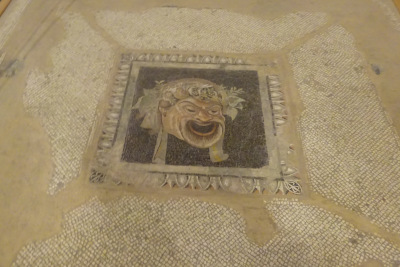 |
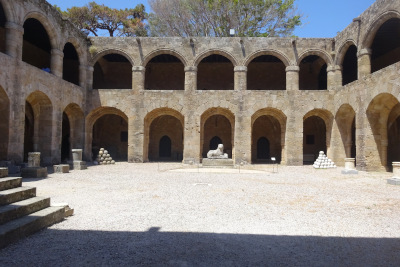 One building that has been pretty much left alone was the actual hospital of the knights, where doctors (assisted by some of the knights, when they were weren't busy pirating around the Aegean) healed people from all over Greece in those centuries. These days the building is used as a museum, showcasing finds from Rhodos' four historic sites, the acropolis of Rhodos City and the three ancient towns of Ialysos, Kameiros and Lindos (named after the three grandsons of Helios the Sun God). Lastly there's the medieval church of the knights, also kept more or less intact though it was used as a mosque during the centuries of Turkish rule. The Ottomans, very much fed up with the knights' pirating and having the christian crusaders at their muslim doorstep, besieged Rhodos in 1522 and evicted them (sending them scuttling to Malta), beginning almost 500 years of Turkish rule until the vast Ottoman Empire crumbled to pieces in 1912 and the Italians moved in for a spell.
One building that has been pretty much left alone was the actual hospital of the knights, where doctors (assisted by some of the knights, when they were weren't busy pirating around the Aegean) healed people from all over Greece in those centuries. These days the building is used as a museum, showcasing finds from Rhodos' four historic sites, the acropolis of Rhodos City and the three ancient towns of Ialysos, Kameiros and Lindos (named after the three grandsons of Helios the Sun God). Lastly there's the medieval church of the knights, also kept more or less intact though it was used as a mosque during the centuries of Turkish rule. The Ottomans, very much fed up with the knights' pirating and having the christian crusaders at their muslim doorstep, besieged Rhodos in 1522 and evicted them (sending them scuttling to Malta), beginning almost 500 years of Turkish rule until the vast Ottoman Empire crumbled to pieces in 1912 and the Italians moved in for a spell.
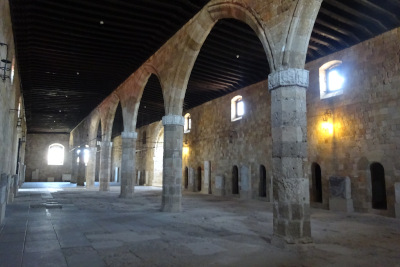
|
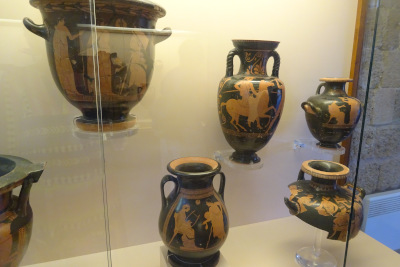 |
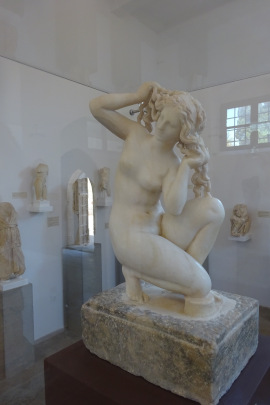
|
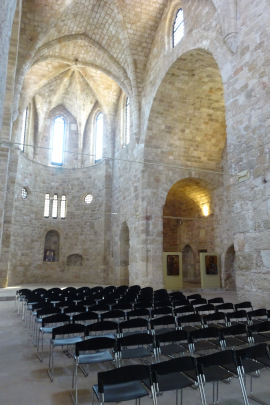
|
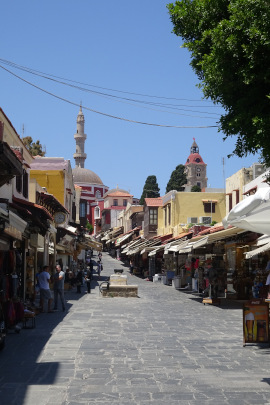 |
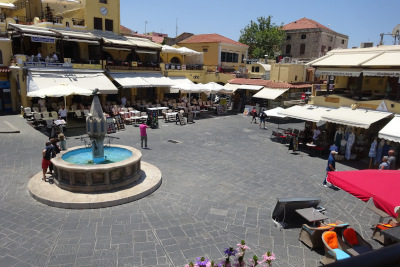 One of the few memories I have of the first trip was a small square in the city where we had fish in a lovely restaurant on the upper floor overlooking the square. Thanks to Google Maps I figured out that this was Hippocrates Square (though it's really impossible to miss as the touristy streets all converge here) and we returned to the same restaurant for another meal now, before leaving Rhodos City behind.
One of the few memories I have of the first trip was a small square in the city where we had fish in a lovely restaurant on the upper floor overlooking the square. Thanks to Google Maps I figured out that this was Hippocrates Square (though it's really impossible to miss as the touristy streets all converge here) and we returned to the same restaurant for another meal now, before leaving Rhodos City behind. We decided to drive along the East coast for a bit to check out Ialysos, where we had planned to stay - and to take a look at the Electra Palace Hotel, where we stayed back then. We even found it again, but sadly it hadn't yet re-opened, so we couldn't waltz in to have a look around and see how much it had changed. The area most certainly had - I do remember that the hotel was all alone in the middle of nowhere back then with a small road leading through fields to the bus stop on the main street and now it was all built-up with touristy clutter like hotels, restaurants, shopping arcades, car rentals and so on. Still, a lovely outing on the whole and for me the first time I really consciously saw Rhodos City and appreciated its history.
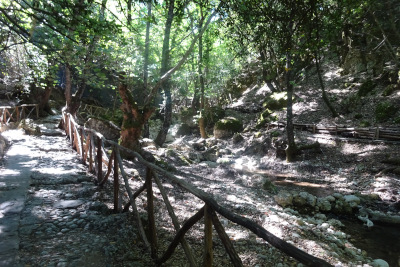
The second day's outing began with a drive into the mountains to Rhodos' famous "Valley of the Butterflies", where supposedly millions of endemic butterflies, the Panaxia Quadripunctaria, live and flutter around you in huge swarms. Clearly they hadn't got the memo that the tourists were back, because I only spotted very few of them and didn't really catch them on a good photo. All the same it was lovely to walk through the enchanted quiet valley along a small stream under huge trees I hadn't even expected in Greece.
From there on we drove to Kameiros, one of the three ancient cities of Rhodos (which we had visited back then but which I don't remember at all). As it turned out, there's really quite a lot left to see with the ruins of the Greek settlement stretching out underneath the ancient temple in an impossibly pretty location:
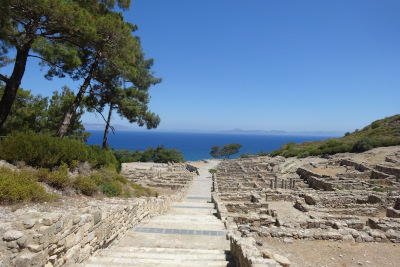
|
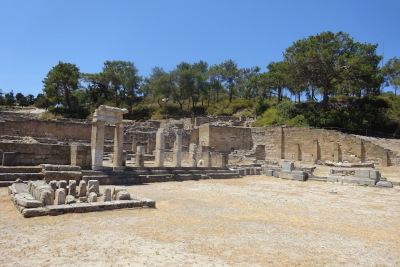 |
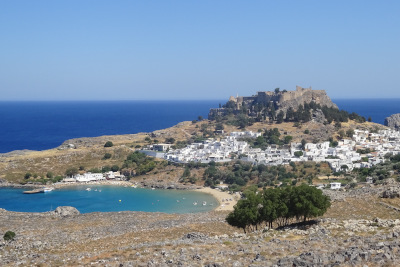
But speaking of pretty, the most lovely place in Rhodos was still to come for the grand finale: Lindos, a small white village between one of Rhodos' few proper sandy beaches and the imposing acropolis on top of the hill. I remember faintly that even back in 1979 there was a rule that the beach should not be built up and I'm really glad for this gorgeous place that they stuck to their guns, keeping Lindos the little gem it is (even though quite overrun with daytrippers). We first went to the beach for a late lunch and then toiled up all the way to the acropolis, which in ancient times was home to Rhodos' most sacred site, the temple of Athena Lindia. Not much is left now and what's there to see is the result of mostly reconstructions, but it was still quite an impressive sight not least because of the breathtaking location:
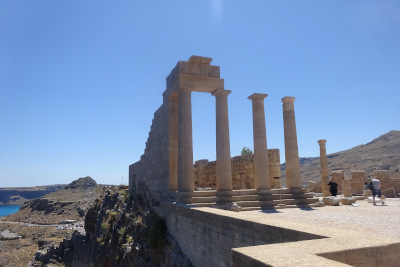
|
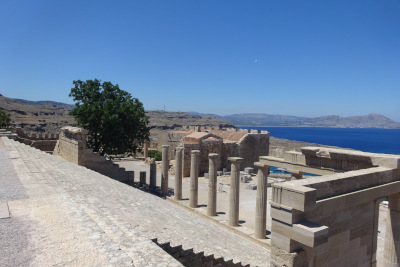 |
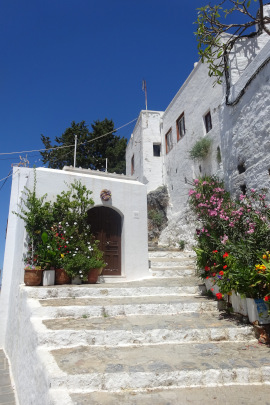
Lindos also felt far more Greek than Rhodos City with its mix of Crusader and Ottoman heritage, reminding me very much of Santorini last year. Coming down from the acropolis, we wandered around the small picturesque alleys and its many tourist shops for a while, then finally returned to the car and back to our resort.
The last day was once again spent completely at the beach there, as there just wasn't anywhere else to go. And while this choice had been forced upon us now, I also realized that it's not really how I like my holidays, I much prefer to have a small city around me or at least a long beach street lined with restaurants, shops and bars to stroll around in the evening, have my meals wherever I like and eat whatever I feel like (while the food was of course splendid as can be expected in a five-star-hotel, I'd really rather sit in a regular Greek taverna with a plate of souvlaki or moussaka).
Nonetheless, while Rhodos didn't charm me as much as Santorini had last year and the trip didn't feel as wonderfully liberating as my escape to the Maldives in spring, it was still some lovely days out and great to revisit this island of which I only had a few fuzzy memories.
P.S: Just for the fun of it, I tried to recreate a few of our old photos and shared them on Facebook in "how it started... how it's going" style, so here they are again:
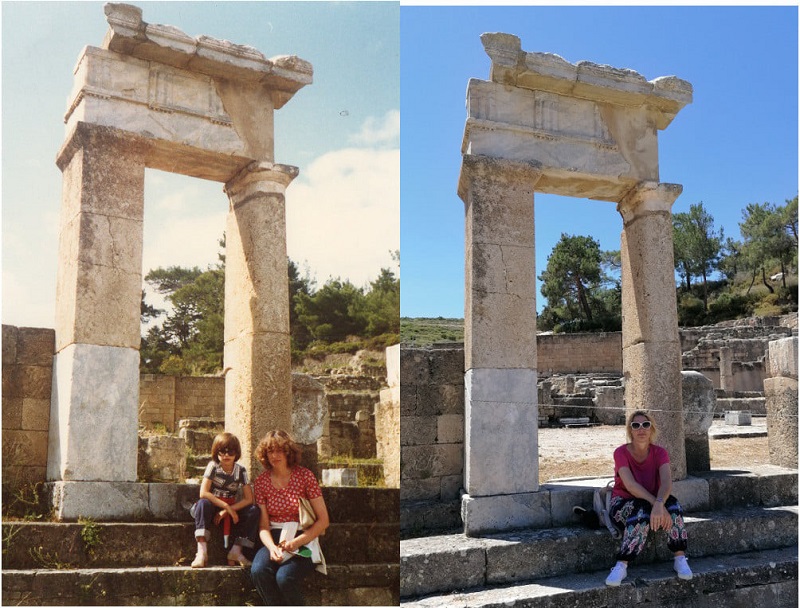
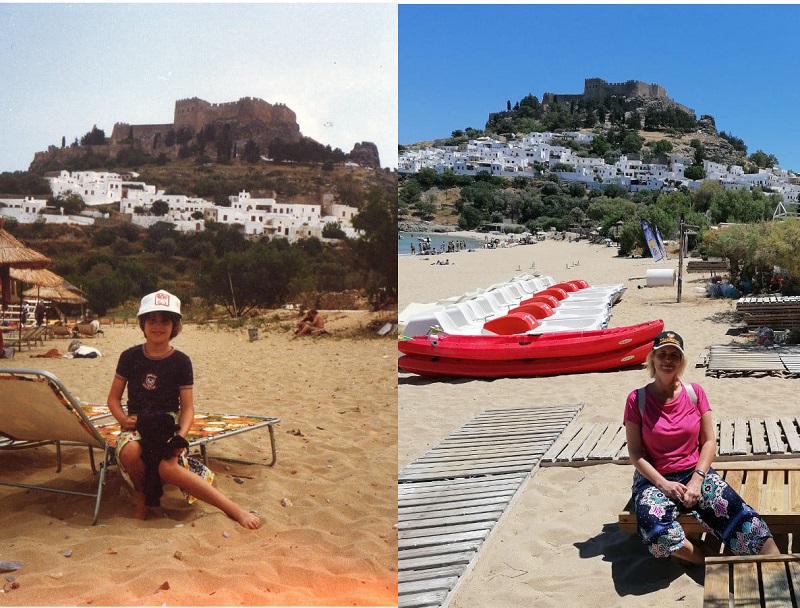
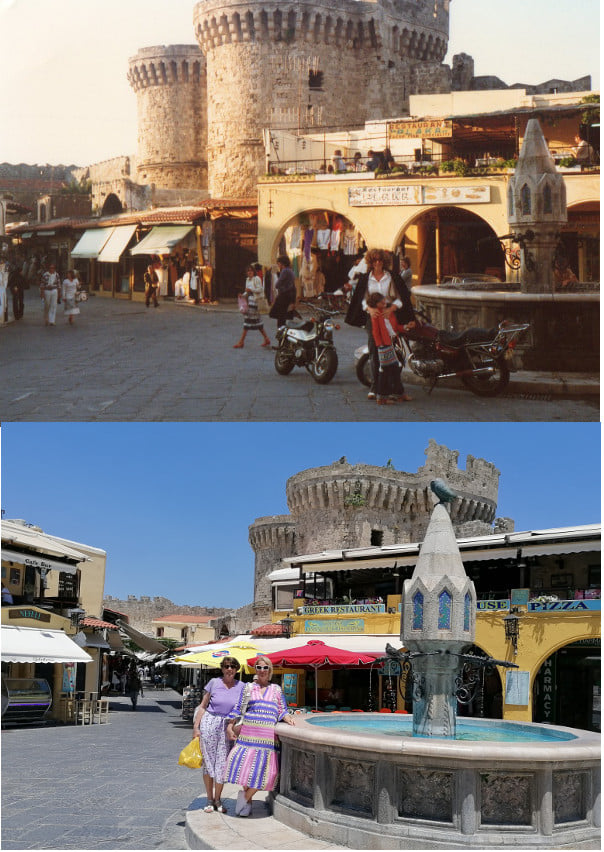
Copyright © All Rights Reserved